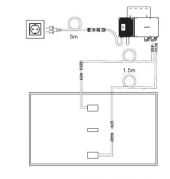jameshowison
New Member
- Joined
- Jul 30, 2021
- Messages
- 184
I watched a youtube video from Germany about an Anker Solix "balcony" solar system. Anyone on here use something like this?

The manual shows that it is panels, connected to a micro-inverter, then plugged straight into an outdoor outlet. Figure seems to show a connector that ends in a male (aka normal, Schuko) plug, so that the system can feed power into the building. There are no batteries or charge controller (nothing to charge). Just creates 240v and offsets electricity usage.
Anyone on here know more about these?
So. Many. Questions.
Is there something that stops voltage on the exposed pins if someone unplugs the system? Or could this just flop around nailing people with 240v power? In the US they call this "normal outlet as input for a generator" a "suicide cable" ... but maybe there is something I'm missing (amps generated too low? I think 800W system through a micro-inverter could only generate about 3amps of 240v power (manual says 2.6amps), but I think that's still enough for trouble!
Given that you are back-feeding a circuit, what is to stop this power "heading onto the grid and killing a lineman"? That's also something people are very concerned about in the US, hence the need for transfer switches or generator interlocks. Are you meant to turn off the incoming circuit breaker so that power on that circuit is only coming from the Solar? But the video implied that this was just offsetting usage.
Hmmm, manual says (in tiny script), "Note: According to the government's regulations and to ensure safety, the microinverter can only start working after connecting to a powered grid for 5 minutes." So maybe if the power goes out the system stops working? And maybe as soon as it stops sensing power on the circuit the system turns off, so if you flop the male pins around they can't have voltage on them?
Oh, and they have a battery option too, so is that including an AC charger to convert the micro-inverted DC to AC then back to DC to charge the battery?
Anyway, seems like a curious product.

The manual shows that it is panels, connected to a micro-inverter, then plugged straight into an outdoor outlet. Figure seems to show a connector that ends in a male (aka normal, Schuko) plug, so that the system can feed power into the building. There are no batteries or charge controller (nothing to charge). Just creates 240v and offsets electricity usage.
Anyone on here know more about these?
So. Many. Questions.
Is there something that stops voltage on the exposed pins if someone unplugs the system? Or could this just flop around nailing people with 240v power? In the US they call this "normal outlet as input for a generator" a "suicide cable" ... but maybe there is something I'm missing (amps generated too low? I think 800W system through a micro-inverter could only generate about 3amps of 240v power (manual says 2.6amps), but I think that's still enough for trouble!
Given that you are back-feeding a circuit, what is to stop this power "heading onto the grid and killing a lineman"? That's also something people are very concerned about in the US, hence the need for transfer switches or generator interlocks. Are you meant to turn off the incoming circuit breaker so that power on that circuit is only coming from the Solar? But the video implied that this was just offsetting usage.
Hmmm, manual says (in tiny script), "Note: According to the government's regulations and to ensure safety, the microinverter can only start working after connecting to a powered grid for 5 minutes." So maybe if the power goes out the system stops working? And maybe as soon as it stops sensing power on the circuit the system turns off, so if you flop the male pins around they can't have voltage on them?
Oh, and they have a battery option too, so is that including an AC charger to convert the micro-inverted DC to AC then back to DC to charge the battery?
Anyway, seems like a curious product.


